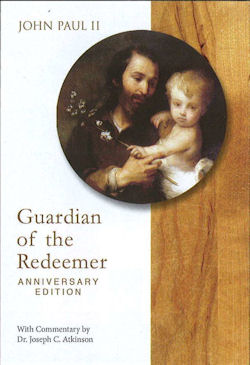
|
Posted August 6, 2014
Book: Guardian of the Redeemer Author: John Paul II Pauline Books & Media, Boston. 2014. Pp. 72 An Excerpt from the Preface:
On the 100th anniversary of Leo XIII's encyclical on Saint Joseph, Quamquam Pluries, John Paul II decided to turn his gaze, and thereby the gaze of the whole Church, upon the guardian of Jesus, the spouse of Mary, and the patron of the universal Church. The pope's aim was to encourage all to grow in their devotion to Saint Joseph. Saint Joseph's importance as husband and father was recognized from the beginning of the Church and recorded in Scripture. Nonetheless, devotion to Saint Joseph followed a rather long and slow trajectory. Clearly Joseph played a key role in the initial preparation for the Incarnation. Yet he was taken officially into the heart of the Church's liturgical life only after centuries of theological development. It was not until 1962, in fact, that John XXIII at Vatican Counsel II inserted Joseph's name into the Roman Canon of the Mass. While it appears that specific forms of devotion to Joseph developed in the early centuries of the Coptic Church (and were often associated with the flight into Egypt), it was not until the Middle Ages that a cult of Saint Joseph began in the West. In 1359 Saint Joseph's name was added to the Litany of Saints, but it was omitted during the Tridentine reforms of the sixteenth century and restored again in 1726. The first indulgenced novena to Saint Joseph was approved in 1713 by Clement XI, yet it was not until 1909 that Pius X gave formal approval to a public litany of Saint Joseph. . . .The unique contribution John Paul II makes in this document is his emphasis on the realism of Joseph and Mary's marriage. In Catholic theology there is no room for dualism, which views the body and the soul in opposition to each other. For human persons both the body and the spirit are essential, yet they are configured in a specific manner John Paul II boldly states that it is as important for the Church to uphold the reality of Joseph and Mary's marriage as it is to profess the virginal conception of Jesus. Unflinchingly, the Holy Father addresses the seeming impossibility for virginity and real conjugal love to co-exist in their marriage. He carefully unpacks the paradox here and shows how these mutually exclusive loves can, in fact, be united in one who is sanctified. Virginity and conjugal love are thus intrinsically related. On this basis, John Paul II demonstrates how by the Spirit conjugal love is perfected in Saint Joseph. Joseph is less a father or a husband, rather he actually realizes the full meaning of both through the total gift of self. An Excerpt from the Book: Often we think of faith and religion as an experience that sets us free or elevates us. While such experiences are important, they are the fruit of a much deeper reality. God calls us to freedom through obedience. There is no other way. John Paul II begins his meditation on the guardianship of Saint Joseph by referring to the teaching of Vatican II, which states that when God reveals himself we are called to make "the full submission of intellect and will" to him. Mary did this by speaking her fiat while Joseph did this through his actions. Each was obedient to the role they had to play in the plan of salvation, and so they became the "first guardians" of the divine mystery. Table of Contents: Part I The Gospel portrait Part II The guardian of the mystery of God Part III A just man --- a husband Part IV Work as an expression of love Part V The primacy of the interior life Part VI Patron of the Church in our day |
|
